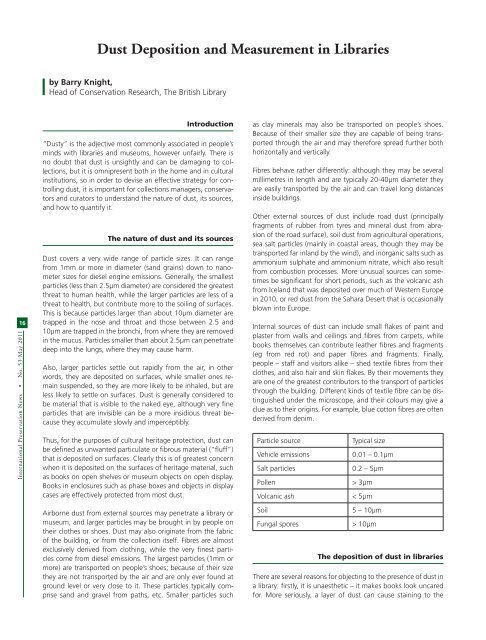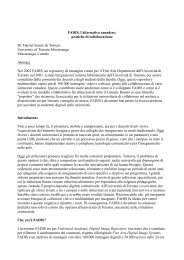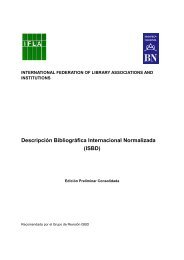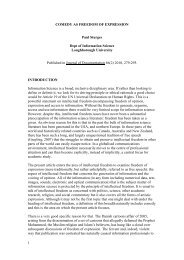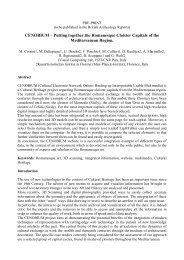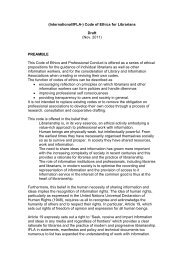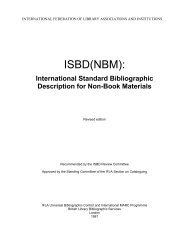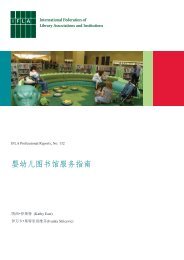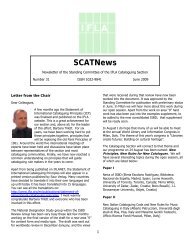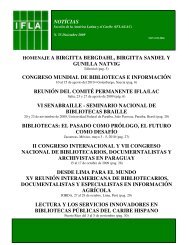Low Cost Dust Monitoring at The British Library - IFLA
Low Cost Dust Monitoring at The British Library - IFLA
Low Cost Dust Monitoring at The British Library - IFLA
You also want an ePaper? Increase the reach of your titles
YUMPU automatically turns print PDFs into web optimized ePapers that Google loves.
16<br />
Intern<strong>at</strong>ional Preserv<strong>at</strong>ion News No. 53 May 2011<br />
<strong>Dust</strong> Deposition and Measurement in Libraries<br />
by Barry Knight,<br />
Head of Conserv<strong>at</strong>ion Research, <strong>The</strong> <strong>British</strong> <strong>Library</strong><br />
Introduction<br />
“<strong>Dust</strong>y” is the adjective most commonly associ<strong>at</strong>ed in people’s<br />
minds with libraries and museums, however unfairly. <strong>The</strong>re is<br />
no doubt th<strong>at</strong> dust is unsightly and can be damaging to collections,<br />
but it is omnipresent both in the home and in cultural<br />
institutions, so in order to devise an effective str<strong>at</strong>egy for controlling<br />
dust, it is important for collections managers, conserv<strong>at</strong>ors<br />
and cur<strong>at</strong>ors to understand the n<strong>at</strong>ure of dust, its sources,<br />
and how to quantify it.<br />
<strong>The</strong> n<strong>at</strong>ure of dust and its sources<br />
<strong>Dust</strong> covers a very wide range of particle sizes. It can range<br />
from 1mm or more in diameter (sand grains) down to nanometer<br />
sizes for diesel engine emissions. Generally, the smallest<br />
particles (less than 2.5µm diameter) are considered the gre<strong>at</strong>est<br />
thre<strong>at</strong> to human health, while the larger particles are less of a<br />
thre<strong>at</strong> to health, but contribute more to the soiling of surfaces.<br />
This is because particles larger than about 10µm diameter are<br />
trapped in the nose and thro<strong>at</strong> and those between 2.5 and<br />
10µm are trapped in the bronchi, from where they are removed<br />
in the mucus. Particles smaller than about 2.5µm can penetr<strong>at</strong>e<br />
deep into the lungs, where they may cause harm.<br />
Also, larger particles settle out rapidly from the air, in other<br />
words, they are deposited on surfaces, while smaller ones remain<br />
suspended, so they are more likely to be inhaled, but are<br />
less likely to settle on surfaces. <strong>Dust</strong> is generally considered to<br />
be m<strong>at</strong>erial th<strong>at</strong> is visible to the naked eye, although very fi ne<br />
particles th<strong>at</strong> are invisible can be a more insidious thre<strong>at</strong> because<br />
they accumul<strong>at</strong>e slowly and imperceptibly.<br />
Thus, for the purposes of cultural heritage protection, dust can<br />
be defi ned as unwanted particul<strong>at</strong>e or fi brous m<strong>at</strong>erial (“fl uff”)<br />
th<strong>at</strong> is deposited on surfaces. Clearly this is of gre<strong>at</strong>est concern<br />
when it is deposited on the surfaces of heritage m<strong>at</strong>erial, such<br />
as books on open shelves or museum objects on open display.<br />
Books in enclosures such as phase boxes and objects in display<br />
cases are effectively protected from most dust.<br />
Airborne dust from external sources may penetr<strong>at</strong>e a library or<br />
museum, and larger particles may be brought in by people on<br />
their clothes or shoes. <strong>Dust</strong> may also origin<strong>at</strong>e from the fabric<br />
of the building, or from the collection itself. Fibres are almost<br />
exclusively derived from clothing, while the very fi nest particles<br />
come from diesel emissions. <strong>The</strong> largest particles (1mm or<br />
more) are transported on people’s shoes; because of their size<br />
they are not transported by the air and are only ever found <strong>at</strong><br />
ground level or very close to it. <strong>The</strong>se particles typically comprise<br />
sand and gravel from p<strong>at</strong>hs, etc. Smaller particles such<br />
as clay minerals may also be transported on people’s shoes.<br />
Because of their smaller size they are capable of being transported<br />
through the air and may therefore spread further both<br />
horizontally and vertically.<br />
Fibres behave r<strong>at</strong>her differently: although they may be several<br />
millimetres in length and are typically 20-40µm diameter they<br />
are easily transported by the air and can travel long distances<br />
inside buildings.<br />
Other external sources of dust include road dust (principally<br />
fragments of rubber from tyres and mineral dust from abrasion<br />
of the road surface), soil dust from agricultural oper<strong>at</strong>ions,<br />
sea salt particles (mainly in coastal areas, though they may be<br />
transported far inland by the wind), and inorganic salts such as<br />
ammonium sulph<strong>at</strong>e and ammonium nitr<strong>at</strong>e, which also result<br />
from combustion processes. More unusual sources can sometimes<br />
be signifi cant for short periods, such as the volcanic ash<br />
from Iceland th<strong>at</strong> was deposited over much of Western Europe<br />
in 2010, or red dust from the Sahara Desert th<strong>at</strong> is occasionally<br />
blown into Europe.<br />
Internal sources of dust can include small fl akes of paint and<br />
plaster from walls and ceilings and fi bres from carpets, while<br />
books themselves can contribute le<strong>at</strong>her fi bres and fragments<br />
(eg from red rot) and paper fi bres and fragments. Finally,<br />
people – staff and visitors alike – shed textile fi bres from their<br />
clothes, and also hair and skin fl akes. By their movements they<br />
are one of the gre<strong>at</strong>est contributors to the transport of particles<br />
through the building. Different kinds of textile fi bre can be distinguished<br />
under the microscope, and their colours may give a<br />
clue as to their origins. For example, blue cotton fi bres are often<br />
derived from denim.<br />
Particle source Typical size<br />
Vehicle emissions 0.01 – 0.1µm<br />
Salt particles 0.2 – 5µm<br />
Pollen > 3µm<br />
Volcanic ash < 5µm<br />
Soil 5 – 10µm<br />
Fungal spores > 10µm<br />
<strong>The</strong> deposition of dust in libraries<br />
<strong>The</strong>re are several reasons for objecting to the presence of dust in<br />
a library: fi rstly, it is unaesthetic – it makes books look uncared<br />
for. More seriously, a layer of dust can cause staining to the


